
- standing rigging
- rope and line
- cams, cleats and clutches
- head sail gear
- roller furling
- main sail control
- mast hardware
- eye straps and pad eyes
- fairleads and bulls eyes
- anchor and docking
- miscellaneous hardware
- Alexander Roberts
- My Wishlist

turnbuckles
- Customer Service
- Order Tracking
- Your Account
- Store Policies & Info
- Privacy Policy
- Helpful Links
- Payment Methods
Shopping Cart: 0 Items

- Lines & Rigging
- Sailboat Standing Rigging
Turnbuckles
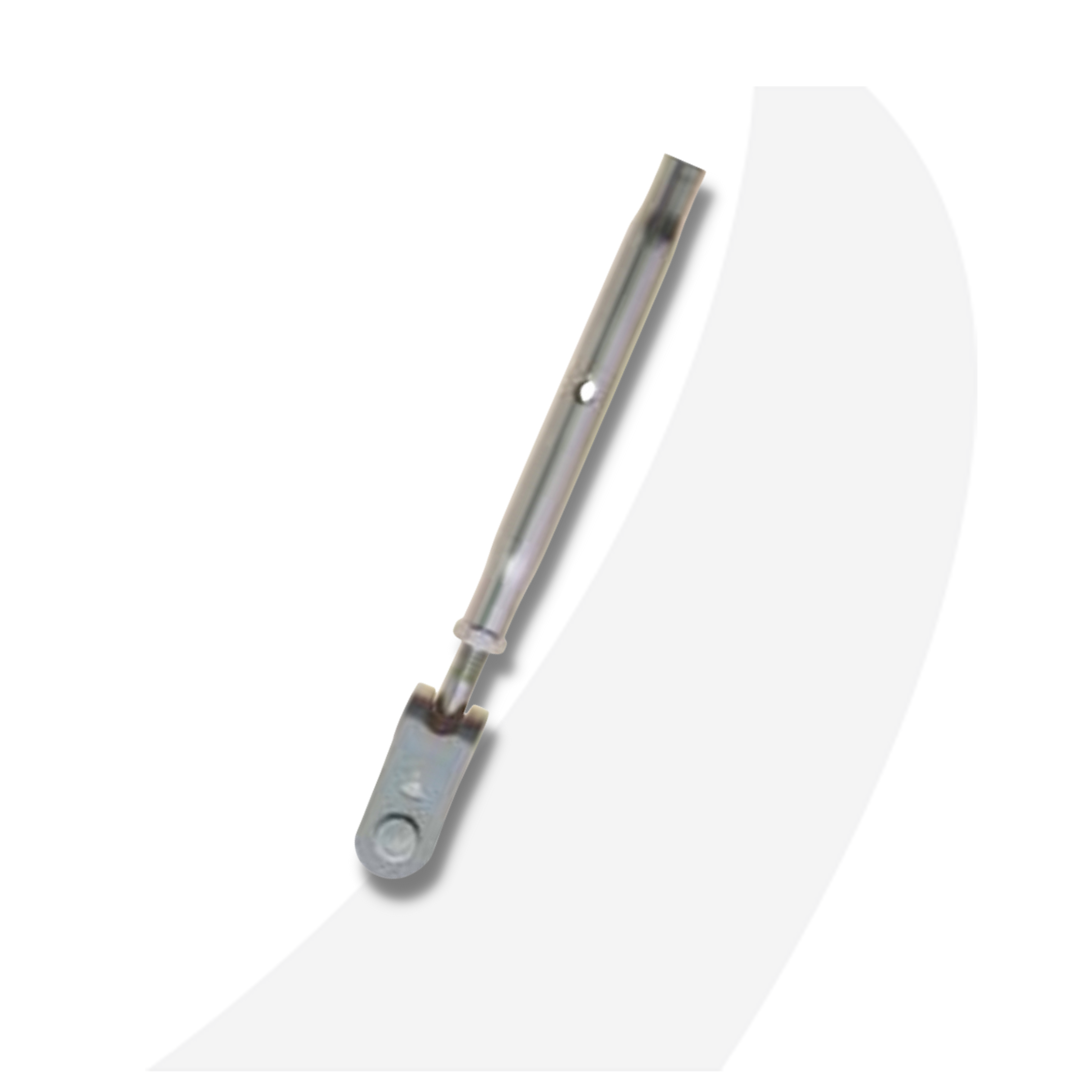
Hayn Marine Eye Toggle to Eye Toggle Turnbuckle 1" Pin 1" Jaw

Hayn Marine Eye Toggle to Eye Toggle Tubular Turnbuckle 1.0" Jaw 1.0" Pin

Hayn Marine Eye Toggle to Eye Toggle Tubular Turnbuckle 7/8" Jaw 7/8" Pin

Hayn Marine Eye to Swage Turnbuckle 16mm Wire 1.0" Eye
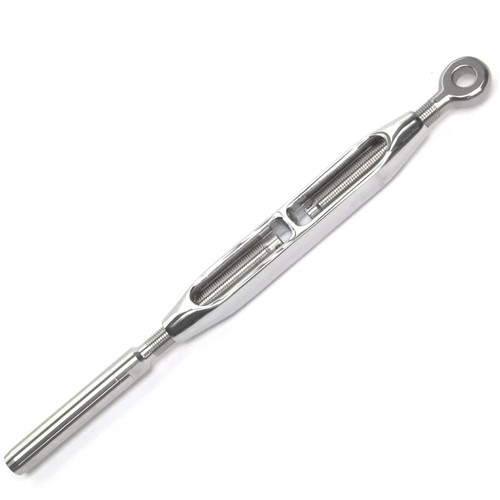
Hayn Marine Eye to Swage Turnbuckle 5/8"Wire 1.0" Eye

Hayn Marine Eye Toggle to Swage Turnbuckle 16mm Wire 1" Jaw
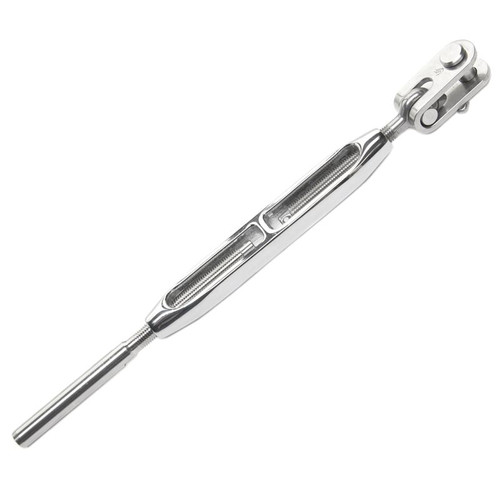
Hayn Marine Eye Toggle to Swage Turnbuckle 5/8" Wire 1" Jaw

Hayn Marine Eye Toggle to Swage Turnbuckle 14mm Wire 1" Jaw

Hayn Marine Eye Toggle to Swage Turnbuckle 9/16" Wire 1" Jaw

Hayn Marine Eye to Swage Tubular Turnbuckle 16mm Wire 1.0" Eye
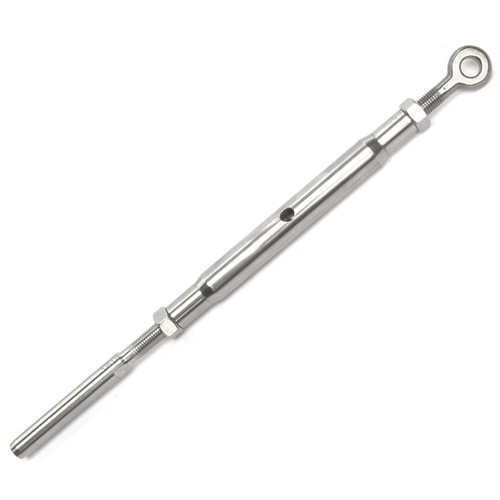
Hayn Marine Eye to Swage Tubular Turnbuckle 5/8"Wire 1.0" Eye

Hayn Marine Eye Toggle to Eye Toggle Turnbuckle 7/8" Pin 7/8" Jaw

Hayn Marine Eye to Swage Tubular Turnbuckle 9/16"Wire 1.0" Eye
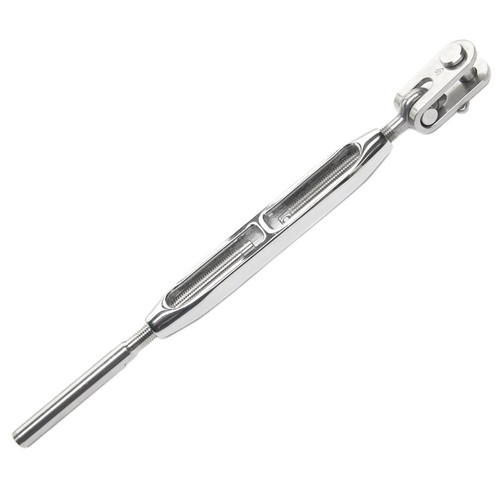
Hayn Marine Eye Toggle to Swage Turnbuckle 14mm Wire 7/8" Jaw

Hayn Marine Eye Toggle to Swage Turnbuckle 9/16" Wire 7/8" Jaw

Hayn Marine Left Hand Eye Toggle & Body Turnbuckle 1" Jaw 1" Pin

Gibb Open Body Turnbuckle Toggle/Toggle with 7/8 Pin

Gibb Open Body Turnbuckle with Fork & Toggle 7/8 Pin

Hayn Marine Left Hand Eye Toggle & Body Turnbuckle 7/8" Jaw 7/8" Pin

Gibb Open Body Turnbuckle 14mm & 9/16" Swage/Toggle 7/8" Pin
How to Adjust a Turnbuckle

The concept of how to properly adjust a turnbuckle seems to sometimes elude most people. This is understandable as I didn’t used to spend my days thinking about tightening cables, like I do now. So let’s take a moment to discuss how this is done properly.
There are generally three different styles of turnbuckles. Yes, there are a few more styles, however these concepts should give you the gist for any turnbuckle.

First things first, always make sure that you start by taking out the cotter pins and removing any old tape.
Generally, to tighten or loosen turnbuckles it is the reverse of what you have learned your whole life, “righty-tighty, lefty-loosey” is now “lefty-tighty, righty-loosey”.
OPEN BODY TURNBUCKLES: The open body style turnbuckle is the most common style in today’s sailboat market and will require either an adjustable wrench and a spike (a ‘beefy’ screw driver should do), or a second adjustable wrench. If you have a turnbuckle that has a swage stud at the top end, then look closely and locate the wrench flat which will be either machined or pressed into the stud by the manufacturer.
NOTE: S ome boats today still have the old, Closed Body/Tubular Style , stainless steel bottles screw type turnbuckle (these should be replaced ASAP with chrome-bronze bodies). To adjust this type of turnbuckle you can use either and appropriately sized Ice Pick or C Sherman Johnson’s purpose made tool (click link and scroll to bottom of page) to stick in the small hole located in the middle of the body. Vise grips or channel locks are not the answer here.
DOUBLE JAWED TURNBUCKLES : You may also have a double jawed turnbuckle which accepts an eye fitting attached to the end of the stay. In this situation it is important to keep the upper jaw/eye end from spinning by using either a spike or screwdriver. Also, please note: these turnbuckles are often installed upside down and not consistently. So figuring out which way is tight and which way is loose can be a doozie and may vary from stay to stay. It may be worth the extra time to make sure they are all configured in the same fashion, matching up with the aforementioned tightening/loosening method (“lefty-tighty, righty-loosey”).
MECHANICAL STUDS AND ROD STUDS : It is also possible that your rigging utilizes a mechanical stud at the top end of the turnbuckle. This is a similar product to that used for open body rod turnbuckles, and the same directions should be followed. Be careful in this situation as the mechanical stud will have two wrench flats, one is to tighten the cap of the mechanical stud (this is NOT the one to use and may cause the fitting to become undone!) and one is to hold the stud in place while turning the turnbuckle body. This wrench flat will sometimes be less noticeable, but if you look closely you will be able to determine which ‘flat’ holds the stud and not the cap.

TURNBUCKLES THAT UTILIZE RIGGING SCREWS for ROD AND WIRE (no longaer available in wire): Next we have the rigging screw style turnbuckle, which was typically provided by Navtec . This looks like an open body turnbuckle, but in reverse. Instead of one body and two studs, there are two bodies and one stud. This is another typical turnbuckle found on rod rigged boats and you should follow these same guidelines here as well. Again, care must be taken to ensure that the upper end of the turnbuckle does not spin. In this case it is the upper body portion that will need to be either held in place by an adjustable wrench or a spike. Then use another wrench to turn the rigging screw by using the wrench flats on the screw.

COQUILLE OR STEM BALL TURNBUCKLES: You have probably noticed by now that I keep making the point of always holding the upper end of the turnbuckle in place, be it a stud, jaw, or body. Well, that is because in most situations the bottom of the turnbuckle is kept from spinning by the way it is pinned to the chainplate . EXCEPT, when the chainplate isn’t conventional. Beneteau is notorious for these types of chainplates. They use what we call a coquille style chainplate, that means essentially, that the connection of the turnbuckle at the deck is a ball and socket type (which means it can spin freely). Here you need to either have three hands and arms, perform a bit’ of a magic trick or grab a friend. Both the top and bottom screws will try to spin in this case, so you will need to hold both upper and lower studs by their wrench flats. I like to go for the “magic trick” method myself, by using large vise grips to grip the lower stud. I will then place my knee near it (as I am in the crouched position) so that the vise grips become wedged up against me as they begin to spin. Then, I will go about holding the upper stud with an adjustable wrench and turning the body with my spike as usual. This maneuver can be a bit tricky, but with a little body contortion and the right tools, it can be done. OR…… simply grab a friend and have them help you ;-0)

When you are done make sure you line up the cotter pin holes in the studs so that the turnbuckle can be pinned. If cotter pins aren’t present then there should be locking nuts of some sort. A turnbuckle ALWAYS needs to be secured so that it cannot become undone.
TIP: No matter what type of turnbuckle you are adjusting make sure the wire, rod or whatever type of stay material you may have, does NOT turn, or is in any way able to become distorted. This can lead to shroud failure!
Remember, if in doubt you can always ask……
Similar Posts
Best crew work ever.
Looking for a good video to inspire your crew. I was pleased to find this gem in the Quantum Racing library. Leave it up to Team Quantum and skipper Terry Hutchinson to demonstrate perfect boat mechanincs. If you have never seen a full crew on TP52 work in harmony before then this is a good…
Nordkapp To Stockholm…..
…… in an inflatable 13′ catamaran. That all adds up to approx. 1350 NM and 45 days. I like that every day he ends with setting up camp and sleeping ashore. This might be the only way I could be talked into this…………on second thought, no, I could never be talked into this. Check out…
Views from Aloft
This week we were aloft to replace a headsail furler. Hood Yacht Systems provided this furler. The Hood Seafurl seems to be a good furler. I’d say my only real tiff with these systems is the rubber liner that is found inside each of the extrusions. The ball bearings are dry lubricated, which I like….
Hood SL Foresail Furlers
When shopping for headsail furlers one can find a wide variety manufacturers such as: Pro Furl, Facnor, Harken, Hood, Bamar, Schaefer, Reckmann, Reefit, CDI; as well as a wide variety of prices. So where does quality and low pricing find a happy marriage? How can one possibly make a decision that’s worthwhile with all of…
Pin and Tape……
…….A term regularly used here at The Rigging Company. Yet this small detail appears to elude most, at least when it comes to doing it correctly. I always say, “details are what make the difference between a professional job and one that is well, not so professional”. If you take notice as to how your…
Classic Lines, Modern Comforts, and…
…easy to handle. The Tofinou 12 is hard to be outdone as far looks and ease of sail handling are concerned. I really like the sort of “Dragon-ish” foredeck design which puts the headstay several feet in from the very point of the boat. This allows the asymmetrical spinnaker to be flown via an internal tack…
Leave a Reply Cancel reply
Your email address will not be published. Required fields are marked *
Save my name, email, and website in this browser for the next time I comment.
10 Comments
- Pingback: Single Sideband Insulators for Backstays – The Rigging Company
The top thread on my turnbuckle doesn’t move when I turn….only the bottom one moves. It seems to be fused. Is there any fix for this or does it need replacement?
You can try a torch, propane or MAP gas, either one. Heat it up … A LOT! Then try and turn. If this doesn’t work, soak it in penetrating oil: PB Blaster, AeroKroil, or even WD40. Let that soak overnight and then try one more time. If still nothing, you might be out of luck and need to look at replacing things.
IF you do get it to turn and notice some metal flakes, bronze or stainless coming out, it will also likely validate replacement.
Hope that helps.
For a 32 foot Catalina sailboat. When is the amount of bury an issue. Or asked another way how little adjustment is OK. Thanks,
Hi, All the way closed is a problem because that’s all there is, no more tensioning is available. All the way open is only a problem if they cannot be pinned/ secured. You always need enough thread bury to get the cotter pin in at the least. Another way to think of it, or in the case of the closed body, you are looking to have at least enough threads engaged to fill the entire threaded section of the body (top and bottom) to be save.
‘Hope that helps.
- Pingback: 101 Tips for Preparing Your Boat for Spring
- Pingback: 101 Tips for Preparing Your Boat for Spring | Rawhide
Remember to keep the upper and lower turnbuckle studs screwed in the same distance…
A great point…..! If unpinning the turnbuckle, definitely take the time to ensure the turnbuckle is balanced. Thanks for taking the time =)
very informative article, i have already save it, we will test our turnbuckle with your methods, thanks a lot!
Username or Email Address
Remember Me
Lost your password?
Review Cart
No products in the cart.

- Privacy Overview
- Strictly Necessary Cookies
This website uses cookies so that we can provide you with the best user experience possible. Cookie information is stored in your browser and performs functions such as recognising you when you return to our website and helping our team to understand which sections of the website you find most interesting and useful.
Strictly Necessary Cookie should be enabled at all times so that we can save your preferences for cookie settings.
If you disable this cookie, we will not be able to save your preferences. This means that every time you visit this website you will need to enable or disable cookies again.
- BOAT OF THE YEAR
- Newsletters
- Sailboat Reviews
- Boating Safety
- Sailing Totem
- Charter Resources
- Destinations
- Galley Recipes
- Living Aboard
- Sails and Rigging
- Maintenance
- Best Marine Electronics & Technology

Sailboat Rigging Tips from a Pro
- By David Bond
- Updated: May 12, 2021
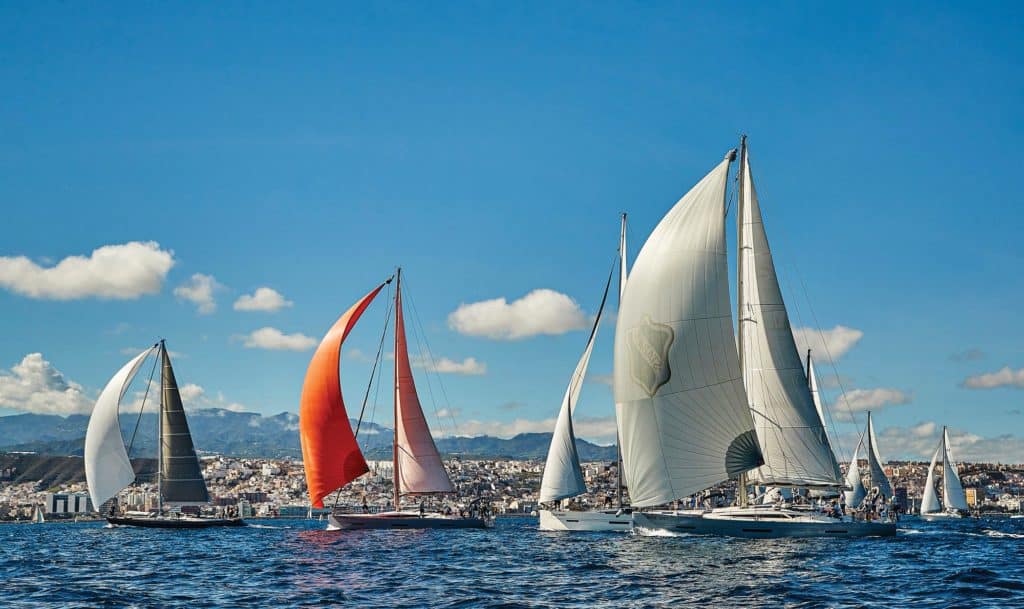
Clive Strickett is a rugged guy, so it takes strong arms to winch him aloft to the masthead. But that’s exactly where you want him: eyeball to halyard sheave, looking for problems. He’s a veteran rigger with a keen eye and a background in ocean racing on the competitive Maxi circuit. On the island of Lanzarote, where I first encountered Strickett, he has a reputation for detail.
We were on the dock at Marina Lanzarote in a fresh breeze of about 20 knots. It was sunny and warm, the sort of weather you’d expect when you’re about 400 nautical miles off the coast of Morocco. These Canary Islands, of which Lanzarote is the farthest north, are a staging area for boats embarking on a trans-Atlantic crossing.
Strickett had just been lowered to the deck of a Bavaria 41 by the boat’s skipper after checking the spreaders, and was now shaking his head. Problems. There are always problems. This time it was mismatched metals. “It’s rare to find a boat that has nothing wrong with it,” he said.
Never mind the Atlantic—the first leg of the trip from the United Kingdom and Europe to the Canaries can be brutal on gear. And that’s before the 3,800-nautical-mile downwind crossing to the Caribbean. It’s wise to have a guy like Strickett check your rig before you leave. “I’ve been doing this for a few years now,” he said. “I might see a problem that the owner missed. They weren’t looking for it, or weren’t looking where they should have been.
“You never know what’s going to happen on boats. Even on new boats,” he continued. “A friend of mine had a new catamaran, a big one, with a carbon-fiber mast. One of the genoa clutches ripped right off the mast. Brand new boat, right from the factory. We had to get the OK from the factory in France to make a repair. We fixed it, and he crossed the Atlantic.”
Minor rig problems compound quickly under pressure. Strong winds funneling through these volcanic islands can mimic trade-wind sailing, but that doesn’t mean that every boat is ready for the crossing. According to Strickett, safety lies in the details, and he points out where to look for potential problems in your rig. Here’s what Strickett is looking for as he inspects a spar, from top to bottom.
Masthead: “Be sure the sheave axles are secure. Sometimes the holes elongate or even crack. And then halyards can get mixed up. One boat that came through here from Tenerife was using the wrong halyard. They were using the spinnaker halyard instead of the genoa halyard. When I went up to look at it, the sheave box was completely gone; the rivets were all loose. The holes had elongated because the halyard was at the wrong angle. They didn’t even realize it. It’s tough to see what’s happening aloft when you’re on deck.”
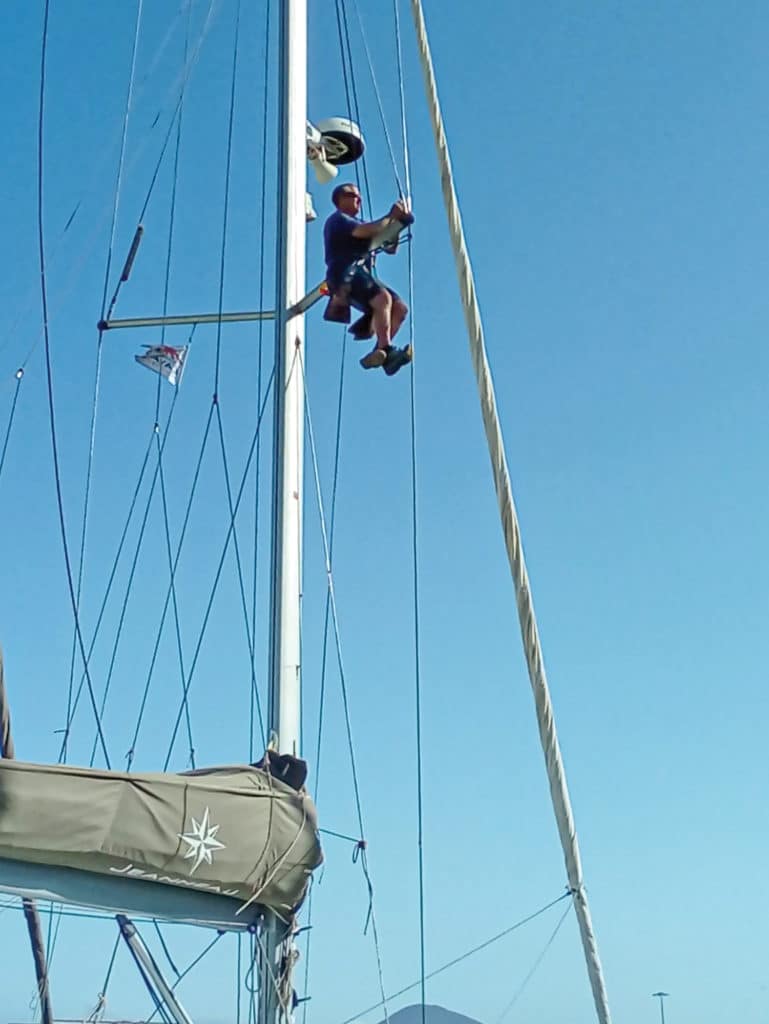
Working down the mast on a fractional rig, there might be additional sheave boxes fitted for internal halyards. “Make sure all the rivets are tight. Anything fitted with bolts or rivets should be double-checked.”
Spreaders: “Inspect the spreader tips; make sure they’re OK and there’s no corrosion. Whenever you get stainless steel and aluminum together, there’s corrosion. One fleet of charter boats here had put 8 mm stainless bolts into the aluminum spreaders with no protection. Now the spreaders are corroding—the holes get bigger and bigger. But not only that, the spreader was already weakened by putting big holes in it to begin with.”
Shrouds: Broken or damaged wire rigging is the most common problem. “Most cruising boats use 1-by-19 stainless wire. Inside, one strand can let go, then another. When you get up to four broken strands, the wire gets weaker and weaker, and eventually fails. If you’re underway and that happens, then you have a big problem.”
You also don’t want extra weight aloft. “Some people use Dyform, or compacted wire, which uses triangular-shaped strands around a core. If you compare a 10 mm Dyform wire to a 10 mm 1-by-19 wire, the Dyform is stronger. I once changed a 12 mm 1-by-19 wire to a 10 mm Dyform wire. It’s the same strength, but I saved some weight aloft.
“You can’t take anything for granted,” he continued. “There was a boat getting ready to head to the Mediterranean from here, which is a long slog to windward. He was all ready to go. Just as an afterthought, the owner had me look over the rig. Good thing. I found some broken wires in the forestay. The whole mast could have come down. So have a close inspection just to make sure there are no broken wires, and that the terminals don’t have any cracks in them.”
Boom: “Once again, closely inspect the rivets. Loose padeyes on the boom get looser and can easily rip right out. The same goes for the gooseneck fittings. Check every bolt, every rivet for the slightest elongation of the holes or any loose rivets. I can’t emphasize that enough. The padeye is usually secured to the boom with 5 mm Monel rivets, but those can pull loose after a sharp pull like a jibe. They can get yanked right out of the boom. Then what? As insurance, I usually remove the 5 mm rivets and replace them with 6.3 mm rivets, which are the largest you can use. If you’ve had a big jibe and the boom hits a V1 (lower shroud), it might break or bend the boom. We fix booms at our engineering shop. They’ll straighten it, put a patch on, weld it and then paint it. That makes it strong enough. New booms delivered to Lanzarote come from France, and the delivery fee alone can cost up to $3,500.”
Read More: Check your Boat’s Rig
Turnbuckles: “Some people don’t like to tape turnbuckles; they like to see what’s going on with them. Fair enough. I wouldn’t tape it all the way closed though. Just a little tape around the split pins so that they don’t grab a sail or your ankle. On one boat that I inspected, the guy had taped up the whole thing. When we untaped it, it was all manky, which means pretty disgusting. The dirt will always get in somehow. If it’s all taped up like that, you can’t oil or lubricate it. I tell people: Now and then, service your turnbuckles. Take some turns off the turnbuckle. Make sure it’s clean and then put a little Teflon gel on it, or some MolyKote grease. Then tighten it back up.
“When you haven’t done it for some years,” he added, “they seize up and you can’t undo them. Especially a small turnbuckle. They’re chrome-plated over bronze, and when you put a big spanner in there and turn it, it’ll snap. And what you don’t want is for a wire to snap when it’s under load. It’s just preventive maintenance. Do it every six months. It takes only a couple of hours.”
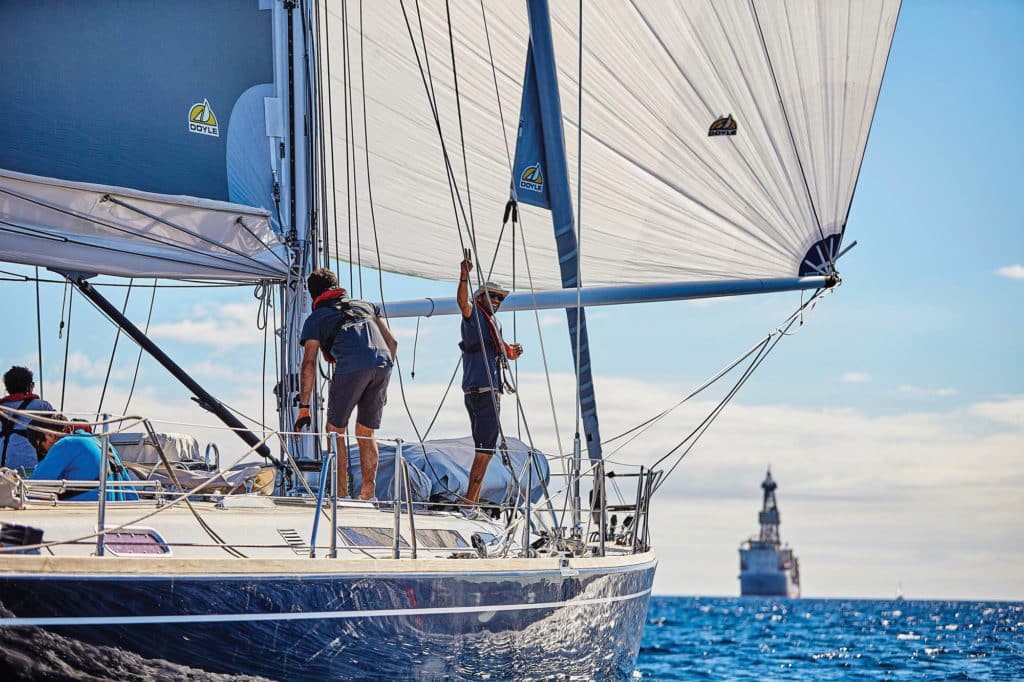
Headsail Furlers: “On some ProFurl furlers, there are four black bolts that go into the furler: two that hold the cage on and two that hold the plate. On the older ones, the bolts are made of titanium, and they seize into the aluminum. I don’t know how many I have had to drill out. But you have to drill them out properly. If it’s a 6 mm bolt, first you drill straight down the middle of the hole with a 3 mm drill, then with a 4 mm, then a 5 mm, then a 5.5 mm. Hopefully it will come out with the heat and friction. ‘Easy-out’ [screw extractors] don’t work. These things are seized together. Even heat doesn’t work.”
Chain Plates: “I inspected one boat with the chain plates so loose, they were actually moving. You could see where they had scratched the paint around the hull. Down below, look carefully at the chain plates. Make sure there’s no cracking in the hull, no movement on the bolts. You can see where a bolt has bent a little, or if it’s been pulled up or down. You’ll see little scratch marks on the hull or the bulkhead.”
Mast Step: “There’s a fine balance between the shrouds being too tight and too loose. There was a good-size catamaran that left here and got into some rough seas, rolling around. The shrouds were too loose, and on one roll, the mast jumped right out of its mast step. It was just for a moment, but in that moment, the mast went overboard.”
With the inspection on the Bavaria completed, as we walked up the gangway toward the marina office, I had one last question: “If something breaks underway, can a rigger or a boatyard be held responsible?”
Strickett answered, “Sometimes. We have a basic form that says something like: ‘Rig checked. All found to be in good condition at the time of inspection.’ And I sign it. So as far as I’m concerned, everything was OK when I signed it. But if along the way, say it blows up to 40 knots and the crew still has their spinnaker up and the mast comes down, well, they might try to come back to us. So in my opinion, it boils down to this: If you’re not up to sailing the boat, then you shouldn’t be there. You just never know what’s going to happen.”
David Bond, a regular contributor to CW, is a writer, teacher and cruising sailor currently based in Germany.
- More: How To , print 2021 april , projects , rig , rigging
- More How To
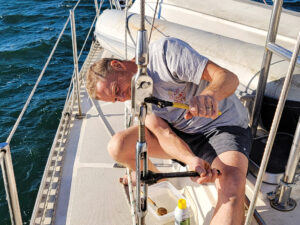
How to Rig Everything in Your Favor
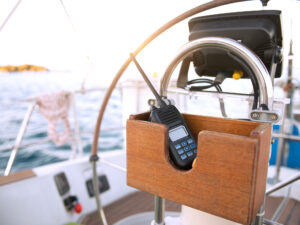
Is There a Doctor Aboard?

3 Clutch Sails For Peak Performance

It’s Time to Rethink Your Ditch Kit

Cruising the Northwest Passage

Balance 442 “Lasai” Set to Debut

A Legendary Sail

10 Best Sailing Movies of All Time
- Digital Edition
- Customer Service
- Privacy Policy
- Email Newsletters
- Cruising World
- Sailing World
- Salt Water Sportsman
- Sport Fishing
- Wakeboarding
- Billing Terms and Conditions
- Shipping and Return Policy
- Shopping Cart
× You are using an outdated browser. Please upgrade your browser to improve your experience.
We Ship Worldwide! | FREE SHIPPING! for US Continental orders over $99. Click for details.

Shopping Cart
Your cart is currently empty..
FREE SHIPPING! for US Continental orders over $99 click for details
Standing Rigging - Open Bodies Turnbuckles

Open Body Turnbuckle - Chromed Bronze - 1/4-28 x 4 1/2" Thread

Tubular Turnbuckle - Stainless Steel - 1/4-28 x 2 3/4" Thread

Tubular Turnbuckle - Stainless Steel - 1/4-28 x 4 1/2" Thread

Forged Bronze Body (Chrome Plated) - 1/4" UNF

Open Body Turnbuckle - Chromed Bronze - 5/16-24 x 5" Thread

Tubular Turnbuckle - Stainless Steel - 5/16-24 x 5" Thread

Forged Bronze Body (Chrome Plated) - 5/16" UNF
Sta-b19-516.

Open Body Turnbuckle - Chromed Bronze - 3/8-24 x 5 1/2" Thread

Tubular Turnbuckle - Stainless Steel - 3/8-24 x 5 1/2" Thread

Forged Bronze Body (Chrome Plated) - 3/8" UNF

Open Body Turnbuckle - Chromed Bronze - 1/2-20 x 6 1/2" Thread

Tubular Turnbuckle - Stainless Steel - 1/2-20 x 6 1/2" Thread

Forged Bronze Body (Chrome Plated) - 1/2" UNF

Turnbuckle Supajust Body - 1/2" UNF

Open Body Turnbuckle - Chromed Bronze - 5/8-18 x 8 1/4" Thread


Tubular Turnbuckle - Stainless Steel - 5/8-18 x 8 1/4" Thread

Forged Bronze Body (Chrome Plated) - 5/8" UNF

Turnbuckle Supajust Body - 5/8" UNF

Open Body Turnbuckle - Chromed Bronze - 3/4-16 x 9 3/4" Thread

Tubular Turnbuckle - Stainless Steel - 3/4-16 x 9 3/4" Thread

Turnbuckle Supajust Body - 3/4" UNF

Open Body Turnbuckle - Chromed Bronze - 7/8-14 x 12 1/2" Thread

Tubular Turnbuckle - Stainless Steel - 7/8 x 10 13/16" Thread

Turnbuckle Supajust Body - 7/8" UNF
Copyright © 2024 mauripro sailing llc..
FREE SHIPPING ON ALL ORDERS OF $150, UNDER 50LBS

- Shop Products ▼
- Order Status
- Shipping Return
- Request Quote
- Rigging & Marine
Turnbuckles
RIGGING SUPPLY YOU CAN DEPEND ON
US Rigging Carries Turnbuckle Wire Tensioners & Cable Tensioners
If you are looking for a turnbuckle you have come to the right place. Our turnbuckles are tough and designed for superior cable termination applications. US Rigging offers a carefully selected variety of Cable Tensioners with various end configurations, including Eye & Eye tensioners, Hook & Eye tensioners, and Jaw & Jaw tensioners. Both standard Stainless Steel Turnbuckles and Galvanized Stainless Steel Turnbuckles are super tough and excellent for outdoor applications.
What Are Turnbuckles Used For?
Turnbuckles may be referred to as Wire Tensioners, Cable Tensioners, or Cable Tighteners. These pieces of hardware are engineered to absorb slack and apply tension to a rigging system without twisting the cables or wires. When Turnbuckles is used in cable termination and tensioning, the Turnbuckle itself will twist rather than the cable or wire.
Turnbuckle Applications And Features:
- Applying Tension To A Rigging Setup
- Taking Up Slack In A Rigging Assembly
- Preventing Wires, Cables, And Lines From Twisting
What Are The Different Styles Of Cable Tensioners?
Turnbuckles/Cable Tensioners are classified by how they attach to assemblies at each end. Turnbuckles have two ends and can be configured with different connectors on each end. For example, a Turnbuckle that has a Hook Connector on one end and an Eye Connector on the other end would be classified as a Hook/Eye Turnbuckle. A Jaw/Jaw Turnbuckle has a Jaw Connector on both ends of the tensioner.
US Rigging Offers 3 Styles Of Turnbuckles:
Eye/Eye Turnbuckles These are tensioners with eyes that connect to other components of a rigging system on both sides of the hardware. Eye connectors add extra security and won’t detach from a rigging system accidentally. Because of this added security, they can be difficult to use in coordination with thimbles.
- Highly Secure Connections
- Won’t Detach From Systems Unintentionally
Jaw/Jaw Turnbuckles With jaws on each end, these turnbuckles include removable pins on each jaw. Jaws work easily with thimbles and are more secure than hook connectors. Like eyes, jaws prevent turnbuckles from becoming detached unintentionally.
- Secure Connections
- Work Easily With Thimbles
Hook/Eye Turnbuckles These turnbuckles have a hook on one end of the hardware and an eye on the opposite end. Hooks are less secure than jaws and eyes but are easily removable. These turnbuckles are ideal for applications where temporary connections are being applied and you want to remove tension more easily.
- Easily Removable
- Ideal For Temporary Connections
What Are The Benefits Of Stainless Steel Wire Tensioners?
Stainless Steel is an incredible material that is excellent for outdoor use, including applications where it may come into contact with salt water. Stainless Steel Is resistant to corrosion and rust. When you are using other components made with Stainless Steel, it is best to use Stainless Steel Turnbuckles to avoid unwanted chemical reactions.
Benefits Of Stainless Steel Turnbuckles:
- Resistant To Corrosion
- Great For Outdoor Use
- Can Come Into Contact With Saltwater
- Ideal For Use With Other Stainless Steel Components
What Are The Benefits Of Galvanized Steel Wire Tensioners?
Galvanized Steel is also great for many outdoor applications but it is not as resistant to corrosion as Stainless Steel. It is resistant to rust against freshwater, but not saltwater.
- Can Come Into Contact With Freshwater
What Turnbuckles Are Best For Heavy Loads?
Turnbuckles with longer thread diameters are the best for heavy loads. If you are working with heavy-duty loads, you will want to compare thread diameters when choosing which Cable Tensioner you are going to buy.
Who Is US Rigging?
US Rigging is a manufacturer and master distributor of climbing ropes, fall protection equipment, and industrial rigging equipment located in Santa Ana, California. This Orange County-based company is proud to provide American Made products with both safety and service in mind. US Rigging has a legacy lasting over 40 years and is known for operational excellence.
We offer a carefully selected array of turnbuckles for cable termination applications where you want to avoid twisting on your line. Browse our selection and choose between Wire Tensioners with a variety of end configurations. Our turnbuckles are available in stainless steel or galvanized steel according to your needs.
US Rigging is committed to excellence in service and providing our customers with the best rigging products on the market.
There are no products listed under this category.
FREQUENTLY ASKED QUESTIONS

Please verify you are a human
Access to this page has been denied because we believe you are using automation tools to browse the website.
This may happen as a result of the following:
- Javascript is disabled or blocked by an extension (ad blockers for example)
- Your browser does not support cookies
Please make sure that Javascript and cookies are enabled on your browser and that you are not blocking them from loading.
Reference ID: 5ea78079-ecf1-11ee-a276-39e904837235
Powered by PerimeterX , Inc.
Sailboat Turnbuckles
Open body turnbuckle, jaw to swage, classic, traditional design. forged silicon bronze body with t-316 stainless ends., email us for quote on open body turnbuckles, tubular turnbuckle, jaw to swage – check nut locking, our most popular life line turnbuckle. check nut locking. t-316 stainless., email us for quote on tubular turnbuckles jaw to swage, tubular slotted turnbuckle, jaw to swage – positive locking rings, unique design features a slot with wraparound rings which fit through a cross-hole in terminal for secure locking. t-316 stainless., email us for quote on tubular slotted turnbuckles, deck toggle turnbuckle, this “t” bolt style fitting is used on decks or bulkheads. toggle nut style also available to match old style. t-316 stainless., email us for quote on deck toggle turnbuckles, “smooth line” turnbuckle, closed thread, very popular architectural turnbuckle also great for life lines. no exposed threads. cable termination is hidden inside of body and rotates on threaded cap. for details see page 4 of architectural section. t-316 stainless., email us for quote on smooth line turnbuckles, adjuster turnbuckle, stamped, strap design turnbuckle with knurled nut for adjustment. t-316 stainless/bronze construction., email us for quote on adjuster turnbuckles, eye to swage – check nut locking, used where an eye is required for attachment instead of a jaw- check nut locking. t-316 stainless., email us for quote on tubular turnbuckles eye to swage, high quality every time., recent projects.
Links to additional photos:
Environmental Center
Loop the Lake Parks & Recreation
Bicycle Shop
Construction Company
Custom Assemblies
Quick Links
Cable Measuring Guide
Inventory Management
Markets Served
Sling Fabrication Equipment
Wire Rope Sizes

Best Sellers in Sailing Rigging Turnbuckles

- Amazon Newsletter
- About Amazon
- Accessibility
- Sustainability
- Press Center
- Investor Relations
- Amazon Devices
- Amazon Science
- Start Selling with Amazon
- Sell apps on Amazon
- Supply to Amazon
- Protect & Build Your Brand
- Become an Affiliate
- Become a Delivery Driver
- Start a Package Delivery Business
- Advertise Your Products
- Self-Publish with Us
- Host an Amazon Hub
- › See More Ways to Make Money
- Amazon Visa
- Amazon Store Card
- Amazon Secured Card
- Amazon Business Card
- Shop with Points
- Credit Card Marketplace
- Reload Your Balance
- Amazon Currency Converter
- Your Account
- Your Orders
- Shipping Rates & Policies
- Amazon Prime
- Returns & Replacements
- Manage Your Content and Devices
- Recalls and Product Safety Alerts
- Conditions of Use
- Privacy Notice
- Your Ads Privacy Choices
JavaScript seems to be disabled in your browser. For the best experience on our site, be sure to turn on Javascript in your browser.
- My Wish List
- Compare Products
- Create an Account
INTRODUCING RONSTAN ORBIT WINCHES™
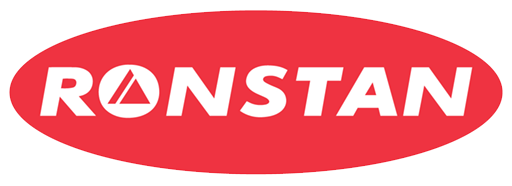
ELEGANT DESIGN, EXCEPTIONAL PERFORMANCE
From their clean lines to the use of the highest grade materials and quality finish, Ronstan Type 10 turnbuckles are engineered to deliver performance while enhancing the appearance of any yacht, or tensile project.
Type 10 closed body turnbuckles have a sleek, modern profile with no sharp edges. They are easily adjusted by turning the unique adjustment nut, which is free to rotate within the sleeve on the turnbuckle body, and are secured with a quick turn on the locking nut. A sight hole is provided in the body to verify adequate thread engagement. With fine thread and single end adjustment, Type 10 turnbuckles are much easier to adjust than conventional turnbuckles, and the use of dissimilar but compatible metals for the threaded components avoids the risk of thread seizure. Toggles are designed with full lateral articulation for easy installation and connection compatibility.

Type 10 Type 10 closed body turnbuckles have a sleek, modern profile with no sharp edges. They are easily adjusted by turning the unique adjustment nut, which is free to rotate within the sleeve on the turnbuckle body, and are secured with a quick turn on the locking nut. A sight hole is provided in the body to verify adequate thread engagement. With fine thread and single end adjustment, Type 10 turnbuckles are much easier to adjust than conventional turnbuckles, and the use of dissimilar but compatible metals for the threaded components avoids the risk of thread seizure. Toggles are designed with full lateral articulation for easy installation and connection compatibility.
Fine, rolled threads Ronstan rigging fittings have rolled threads for maximum strength and reliability – unlike cut threads, the stainless steel bar is formed up and down to create a thread with the grain remaining unbroken and flowing the full length of the thread. Threads are UNF (Unified National Fine), short pitch threads for fine adjustment and reduced adjustment effort.
Roll swage integrity Swage fittings suit industry-standard roll swaging presses and dimensions are derived from the original ‘Milspec’ for maximum integrity. They are suitable for use with modern and traditional wire constructions, including 1x19, 7x19 and compact strand.
Termination options Swage fittings suit industry-standard roll swaging presses and dimensions are derived from the original ‘Milspec’ for maximum integrity. They are suitable for use with modern and traditional wire constructions, including 1x19, 7x19 and compact strand.
Calibrated turnbuckles Swage fittings suit industry-standard roll swaging presses and dimensions are derived from the original ‘Milspec’ for maximum integrity. They are suitable for use with modern and traditional wire constructions, including 1x19, 7x19 and compact strand.
Need some advice?
Official Sponsors of the Australian Sailing Team

The following 6 files are in this category, out of 6 total.

- Medvedev - 2010 Moscow Metro bombings.ogv 16 min 50 s, 480 × 360; 34.77 MB
- Medvedev - Lubyanka.ogv 2 min 0 s, 480 × 360; 5.85 MB

- 2010 events in Moscow
- Terrorist incidents in 2010
- Sokolnicheskaya Line
- History of Moscow Metro
- Terrorist incidents in Moscow
- March 2010 in Moscow
- 2010 in crime in Russia
- Uses of Wikidata Infobox
- Uses of Wikidata Infobox with maps
- Pages with maps
Navigation menu
- Client log in
Metallurgicheskii Zavod Electrostal AO (Russia)
In 1993 "Elektrostal" was transformed into an open joint stock company. The factory occupies a leading position among the manufacturers of high quality steel. The plant is a producer of high-temperature nickel alloys in a wide variety. It has a unique set of metallurgical equipment: open induction and arc furnaces, furnace steel processing unit, vacuum induction, vacuum- arc furnaces and others. The factory has implemented and certified quality management system ISO 9000, received international certificates for all products. Elektrostal today is a major supplier in Russia starting blanks for the production of blades, discs and rolls for gas turbine engines. Among them are companies in the aerospace industry, defense plants, and energy complex, automotive, mechanical engineering and instrument-making plants.
Headquarters Ulitsa Zheleznodorozhnaya, 1 Elektrostal; Moscow Oblast; Postal Code: 144002
Contact Details: Purchase the Metallurgicheskii Zavod Electrostal AO report to view the information.
Website: http://elsteel.ru
EMIS company profiles are part of a larger information service which combines company, industry and country data and analysis for over 145 emerging markets.
Similar companies
Related emis industry reports.

To view more information, Request a demonstration of the EMIS service

IMAGES
VIDEO
COMMENTS
Sailboat rigging turnbuckles and rigging screws used for standing rigging, life lines, architectual, and industrial use made from forged bronze, chrome bronze, and stainless steel are available from Rigging Only. Checkout View Cart (0) (508) 992-0434. Toggle navigation. Shop All . standing rigging;
Sailboat Gibb and Navtec turnbuckles. Wide selection of sailboat rigging terminals and parts. Best prices and technical support at Vela Sailing Store. WE SHIP WORLDWIDE: More Info. Toggle menu. FREE SHIPPING* US Continental (min order $98) International (min order $750)
Trust West Marine for quality rigging hardware. Sailboat turnbuckles and stay adjusters are adjustable terminals located at the base of a sailboat's forestay, backstay or shrouds. They enable you to adjust the length and change the tension of the stays or shrouds. Turnbuckles can have an open- or a closed-body design.
OPEN BODY TURNBUCKLES: The open body style turnbuckle is the most common style in today's sailboat market and will require either an adjustable wrench and a spike (a 'beefy' screw driver should do), or a second adjustable wrench. If you have a turnbuckle that has a swage stud at the top end, then look closely and locate the wrench flat ...
Johnson turnbuckles are designed and manufactured in the USA with quality materials and are built to last in the harsh marine environment. Johnson rigging offers a full line of tubular turnbuckles, along with terminals, toggles, plates, backstay/inner forestay turnbuckles, pins and rings - everything you need to rig and tune your boat safely ...
Work Boat Safety Rail Systems; Furlers. Jib Furlers. Small Boat Drum Furlers; Gennaker Furlers. Furler & Top Swivel; Accessories; Continuous Line Furlers; ... Rigging Hardware; Turnbuckles & Handles; RF1473-05 Handle Kit for 5/16" Threaded Turnbuckle Bodies. Handle kit, suits 5/16" Type 10 threaded turnbuckle body combinations.
Aug 14, 2015. It's one of the most important features on a sailboat, but many owners put standing rigging at the back of their minds when it comes time to do their pre-season safety checks. A prudent sailor should inspect his or her standing rig at least once each season and should know when the time comes to replace most or all of it.
Find your standing rigging Turnbuckles to keep your sail boat's rigging in top shape and ready to take you on your next adventure out on the water. Javascript is disabled on your browser. To view this site, you must enable JavaScript or upgrade to a JavaScript-capable browser.
But you have to drill them out properly. If it's a 6 mm bolt, first you drill straight down the middle of the hole with a 3 mm drill, then with a 4 mm, then a 5 mm, then a 5.5 mm. Hopefully it will come out with the heat and friction. 'Easy-out' [screw extractors] don't work. These things are seized together.
Search by manufacturer's part # or brand. Open bodied and closed bodied turnbuckles for all types of rigging. Sailing Services is a manufacturer and supplier of custom rigging and sailboat hardware for marine and architectural applications.
1-21 results of 21. 1. If you're looking for Alexander Roberts rigging hardware, Fisheries Supply has you covered. We've got all the stainless steel fixed toggles, aircraft type forks, marine eyes, swage studs and Alexander Roberts turnbuckles you need to get your rigging job done right. Shop today and save, or to see our complete line of ...
Shop a full range of Standing Rigging - Open Bodies Turnbuckles at MAURIPRO Sailing Store. Complete tech support and free shipping on orders over $99. ... Open Body Turnbuckle - Chromed Bronze - 7/8-14 x 12 1/2" Thread HAY78FB. $649.00 (List Price: $888.69) Details. Hayn Tubular Turnbuckle - Stainless Steel - 7/8 x 10 13/16" Thread HAY78TB.
Hayn rigging has been setting the standard for quality stainless steel rigging hardware for over 60 years. Hayn Hi-Mod compression fittings and Hayn turnbuckles are manufactured using skilled craftsman and quality materials, while still remaining price competitive. Whether you need jaw to jaw turnbuckles, rigging pins, swage forks or studs ...
Turnbuckles may be referred to as Wire Tensioners, Cable Tensioners, or Cable Tighteners. These pieces of hardware are engineered to absorb slack and apply tension to a rigging system without twisting the cables or wires. When Turnbuckles is used in cable termination and tensioning, the Turnbuckle itself will twist rather than the cable or wire.
Do-it-yourselfers can take advantage of West Marine's complete selection of standing rigging hardware. In addition to 1 x 19 wire, you will find a complete selection of wire terminals to accommodate most applications. Examples include turnbuckles, toggles and a variety of swage fittings. West Marine also offers a complete selection of ...
Closed Thread. Very popular architectural turnbuckle also great for life lines. No exposed threads. Cable termination is hidden inside of body and rotates on threaded cap. For details see page 4 of architectural section. T-316 stainless.
Best Sellers in Sailing Rigging Turnbuckles #1. ... 3/4 x 12" Turnbuckle Hook Eye Galvanized Steel 3000 LBS Marine Boat Shade Sail. 1 offer from $51.50 #31. Turnbuckl H/H 1/4x7-3/4. 6 offers from $10.70 #32. Marine Boat Toggle & Toggle Stainless Steel Pipe TURNBUCKLE 8MM.
Type 10 Type 10 closed body turnbuckles have a sleek, modern profile with no sharp edges. They are easily adjusted by turning the unique adjustment nut, which is free to rotate within the sleeve on the turnbuckle body, and are secured with a quick turn on the locking nut. A sight hole is provided in the body to verify adequate thread engagement.
Round table 2021. "Electrostal" Metallurgical plant" JSC has a number of remarkable time-tested traditions. One of them is holding an annual meeting with customers and partners in an extеnded format in order to build development pathways together, resolve pressing tasks and better understand each other. Although the digital age ...
The New Voice of Ukraine. Local security forces brought 15 men to a military enlistment office after a mass brawl at a warehouse of the Russian Wildberries company in Elektrostal, Moscow Oblast on Feb. 8, Russian Telegram channel Shot reported. 29 people were also taken to police stations. Among the arrested were citizens of Kyrgyzstan.
The following 6 files are in this category, out of 6 total. Blasts Mar2010 on metro map.png 790 × 778; 43 KB. Map of 2010 Moscow Metro bombings.svg 358 × 366; 14 KB. Medvedev - 2010 Moscow Metro bombings.jpg 650 × 434; 67 KB. Medvedev - 2010 Moscow Metro bombings.ogv 16 min 50 s, 480 × 360; 34.77 MB.
Main Activities: Iron and Steel Mills and Ferroalloy Manufacturing | Nonferrous Metal (except Copper and Aluminum) Rolling, Drawing, and Extruding. Full name: Metallurgicheskii Zavod Electrostal AO Profile Updated: February 22, 2024. Buy our report for this company USD 29.95 Most recent financial data: 2022 Available in: English & Russian ...
Baltimore's Francis Scott Key Bridge collapsed after it was struck by a large ship, according to video obtained by CNN. Hear the 911 dispatch the moment it happened.